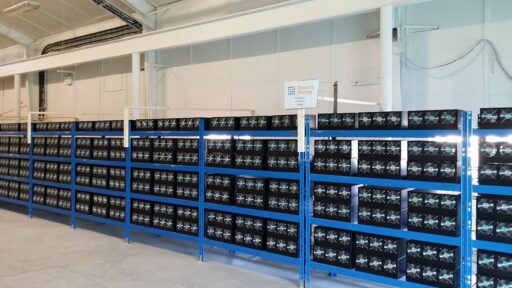In the ever-evolving landscape of digital finance, cryptocurrencies have emerged as a disruptive force, challenging traditional notions of currency and investment. At the heart of this revolution lies the concept of crypto mining, a process integral to the creation and validation of digital currencies like Bitcoin, Ethereum, and beyond. In this article, we delve into the profitability of crypto mining in 2023, examining the economic factors, technological advancements, environmental considerations, and investment perspectives that shape this dynamic field.
Key Takeaways
- Crypto mining profitability in 2023 is heavily influenced by Bitcoin price fluctuations, mining efficiency, and operational costs.
- Technological advancements such as efficient mining hardware and alternative consensus mechanisms are crucial for miners to adapt to hashprice volatility and halving events.
- Environmental and regulatory considerations are becoming increasingly important, with a focus on eco-friendly mining solutions and navigating complex regulations.
- The valuation of mining companies is closely tied to mining profitability, efficiency of operations, and their capacity to utilize the latest technologies.
- Preparing for the future of crypto mining involves understanding its intricacies and developing strategies for long-term success, especially in the context of post-halving scenarios.
The Current State of Crypto Mining Profitability

Recent Trends in Miner Revenues
In the dynamic landscape of crypto mining, miner revenues have seen significant fluctuations. The recent surge in Bitcoin’s price to $72K has propelled miner earnings to unprecedented levels, with daily revenues peaking at $78.6 million on March 7, according to CryptoQuant. This uptick is attributed to the rewards from new coins and transaction fees on the blockchain network.
The competitive nature of mining means that profitability can be a moving target. Miners who maintain operations during cost escalations may benefit from reduced competition, potentially increasing their share of block rewards.
However, the profitability of mining is not solely dependent on Bitcoin’s market value. Factors such as electricity costs, hardware efficiency, and mining difficulty play a pivotal role. For instance, the production costs for less efficient miners are expected to double, emphasizing the need for strategic adaptation and investment in efficient hardware to remain viable.
| Date | Event | Miner Revenue |
|---|---|---|
| Mar 7, 2024 | Bitcoin price near all-time highs | $78.6 million |
| Mar 11, 2024 | Bitcoin reaches new all-time high; Miner revenue | $78.89 million |
Impact of Bitcoin Price Fluctuations on Mining
The profitability of crypto mining, particularly Bitcoin mining, is inextricably linked to the price of Bitcoin itself. When Bitcoin’s price soars, mining becomes more lucrative, leading to increased competition and investment in mining infrastructure. Conversely, when the price drops, miners with higher operational costs may find it difficult to remain profitable, potentially leading to a consolidation in the industry.
The Bitcoin halving event, which occurs approximately every four years, introduces additional volatility. This event cuts the block reward in half, effectively doubling the cost of Bitcoin production for miners. To illustrate the impact of such fluctuations, consider the following table showing the percentage increase in Bitcoin’s price before past halving events:
| Halving Event | % Increase in Price Before Halving |
|---|---|
| 2016 | 142% |
| 2020 | 19% |
While transaction fees can offset some of the increased costs due to halving, they represent a more volatile income stream, adding unpredictability to miners’ revenue.
Investors and miners alike must navigate these price fluctuations and halving events with strategic planning and efficient operations to maintain profitability. The ability to adapt to hashprice volatility and deploy the latest mining technology is crucial, especially in the post-halving landscape.
Cost Analysis for Modern Crypto Mining Operations
The economics of crypto mining have become increasingly complex, with profitability hinging on a delicate balance between operational costs and the value of mined cryptocurrencies. The cost to mine a single bitcoin now ranges from approximately $10,000 to $15,000, with projections suggesting a potential rise to $40,000 post-2024 halving.
To remain competitive, miners are compelled to invest in the latest and most efficient hardware. This is not only a capital-intensive endeavor but also a strategic one, as the right equipment can significantly reduce electricity consumption and improve overall profitability. Here’s a breakdown of the primary costs associated with modern crypto mining operations:
- Hardware Acquisition: The upfront cost of purchasing ASICs or other mining rigs.
- Electricity: The ongoing expense of power, which varies by region and can be the largest operational cost.
- Maintenance: Regular upkeep and repairs to maintain optimal mining conditions.
- Facility: Costs related to housing the mining equipment, including rent, cooling, and security.
With the looming halving event and the increasing difficulty of mining algorithms, miners must not only manage these costs effectively but also anticipate and plan for future changes in the mining landscape.
Investors and mining companies alike must navigate these financial waters carefully, as the efficiency of operations and the ability to adapt to hashprice volatility are pivotal in sustaining profitability. The strategic deployment of the latest mining technologies is not just a matter of staying current; it’s a critical factor in the survival and success of mining endeavors.
Technological Advancements and Their Impact on Mining

The Role of Efficient Mining Hardware
In the dynamic landscape of crypto mining, efficient hardware is the linchpin of profitability. The relentless halving of block rewards compels miners to constantly seek out the latest advancements in mining technology. This drive for efficiency is not only a matter of economic survival but also a contributor to the overall energy reduction of the Bitcoin network.
The evolution of mining hardware has been marked by significant milestones, from the early days of CPUs and GPUs to the current era of ASICs, which offer unparalleled efficiency. The table below illustrates the stark contrast in production costs between the least and most efficient miners, underscoring the importance of staying ahead in the hardware race.
| Miner Efficiency | Production Cost (USD) |
|---|---|
| Least Efficient | $66,000 |
| Most Efficient | Significantly lower |
The pursuit of efficiency is not just about adapting to market trends; it’s about ensuring the longevity and sustainability of mining operations. Miners who fail to upgrade their equipment risk falling behind as profit margins shrink and operational costs soar.
With the shift towards renewable energy sources, miners are not only improving their bottom line but also addressing the environmental concerns associated with crypto mining. This trend towards eco-friendly solutions is reshaping the industry and setting new standards for what it means to mine cryptocurrencies responsibly.
Alternative Consensus Mechanisms
The evolution of consensus mechanisms is a pivotal aspect of the crypto mining landscape. Proof of Work (PoW) has long been the standard, but concerns over its energy consumption have led to the rise of Proof of Stake (PoS) and other methods. These alternative mechanisms aim to reduce the environmental impact and improve scalability.
- Proof of Work (PoW)
- High energy consumption
- Extensive mining hardware
- Proof of Stake (PoS)
- Lower energy requirements
- Staking of coins for validation rights
Embracing alternative consensus mechanisms can be a strategic move for miners and blockchain networks alike, offering a balance between security, efficiency, and sustainability.
The shift towards these alternatives is not just a technical change but also an economic one. Miners must adapt their strategies to remain profitable in a market that increasingly values eco-friendly and efficient operations.
Adapting to Hashprice Volatility and Halving Events
In the ever-evolving landscape of cryptocurrency mining, adapting to hashprice volatility and the periodic Bitcoin halving events is paramount for maintaining profitability. The halving, which occurs approximately every four years, has historically introduced significant volatility in mining profitability and hashprice fluctuations, necessitating a strategic approach for mining operations.
The halving not only affects the immediate economics of mining but also has a ripple effect on the broader market dynamics, influencing Bitcoin’s value and the valuation of mining companies.
For miners and investors alike, understanding and preparing for these events is crucial. Here’s a concise look at the implications:
- Operational efficiency: Becoming paramount post-halving.
- Advanced technology: Adoption is key for sustaining profitability.
- Market cycles: Halving influences Bitcoin’s value and trading strategies.
- Data analytics: Tools like Glassnode provide insights for pre and post-halving market navigation.
2022 saw a challenging shift in cryptocurrency mining profitability, filtering out less efficient miners. Market dynamics show resilience and growth, with a focus on efficiency and future prospects. For those in the mining sector, staying informed and agile will be essential to thrive in the face of these cyclical challenges.
Environmental and Regulatory Considerations

Navigating Crypto Mining Regulations
As the crypto mining industry continues to mature, regulatory scrutiny is intensifying across the globe. Navigating the complex web of regulations is crucial for miners who must comply with varying legal frameworks that differ by country and sometimes even within regions.
- United States: Compliance with SEC, IRS, and specific state-level regulations.
- European Union: Adherence to AMLD5 and upcoming Markets in Crypto-Assets (MiCA) regulations.
- China: Navigating through the outright ban on crypto activities.
- Canada: Following the guidelines of the Canadian Securities Administrators (CSA).
Miners must stay informed and agile, adapting their operations to the ever-changing regulatory landscape to avoid penalties and ensure the longevity of their mining endeavors.
The ability to swiftly adapt to new regulations can be a significant competitive advantage. It’s not just about compliance; it’s about seizing opportunities within the legal frameworks to optimize operations and potentially access new markets.
Eco-Friendly Mining Solutions
In the pursuit of sustainability, mining efficiency has become a central focus for crypto miners. The industry is witnessing a paradigm shift towards the use of renewable energy sources, which not only reduces the carbon footprint but also potentially lowers operational costs. This transition is a response to the growing environmental concerns and the need for more cost-effective mining practices.
- Adoption of solar, wind, and hydroelectric power sources
- Utilization of excess natural gas from oil fields
- Investment in carbon offset initiatives
- Development of energy-efficient mining hardware
The emphasis on eco-friendly solutions is not just about being environmentally responsible; it’s also about economic viability. As the reward for mining new blocks is halved, the pressure mounts for miners to innovate and maintain profitability. This has led to the creation of more energy-efficient hardware and optimized operations, contributing to a greener Bitcoin network.
The integration of eco-friendly practices in crypto mining is essential for the industry’s long-term sustainability and public image. It represents a commitment to addressing the critical concerns of energy consumption while striving for profitability in an ever-evolving market.
The Debate Over Crypto Mining’s Carbon Footprint
The carbon footprint of crypto mining has been a contentious issue, with debates centering on the energy consumption and environmental impact of mining operations. As the industry seeks to balance profitability with sustainability, the focus has shifted towards more eco-friendly mining solutions.
- Renewable energy sources are being increasingly adopted by miners.
- Innovations in mining hardware aim to enhance mining efficiency.
- The industry is exploring ways to reduce the overall energy consumption of the Bitcoin network.
The necessity to maintain profitability post-halving has spurred a culture of innovation, leading to more energy-efficient practices and a potential reduction in crypto mining’s carbon footprint.
The global economic impact of cryptocurrency mining, alongside the energy consumption debates, underscores the importance of focusing on sustainability. This is not only crucial for the environment but also for the long-term viability of the mining industry itself.
Investment Perspectives on Crypto Mining Stocks

Assessing the Valuation of Mining Companies
In the dynamic landscape of crypto mining, the valuation of mining companies is a complex interplay of various factors. Investors must scrutinize the efficiency of mining operations and their resilience to hashprice volatility, as these elements are pivotal in determining a company’s profitability, especially in the wake of halving events. The ability to swiftly deploy the latest mining technology is also a key determinant of a company’s market position and financial health, which in turn influences investor confidence and stock performance.
The halving event introduces significant volatility in mining profitability and hashprice fluctuations, which are critical factors affecting the valuations of Bitcoin mining companies. Operational efficiency and the adoption of advanced technology become paramount for sustaining success post-halving.
Mining firms are increasingly focusing on efficiency and lean operations to navigate the post-halving economic environment. Upgrading to more energy-efficient equipment and expanding mining facilities are strategic moves being made in anticipation of the halving. However, this period also sees increased financial pressure on cash-strapped firms, leading to a consolidation in the industry where larger firms may acquire smaller operations. The following points highlight the key considerations for investors assessing mining company valuations:
- Profitability and its impact on financial outlook
- Adaptation to hashprice volatility
- Technological advancements and operational efficiency
- Industry consolidation and acquisition trends
The Effect of Mining Profitability on Stock Evaluations
The profitability of crypto mining is a pivotal factor in the valuation of mining companies’ stocks. Investors must scrutinize various elements that influence profitability, such as electricity costs, market conditions, mining difficulty, and hardware efficiency. These factors not only affect the immediate financial performance but also the long-term viability of mining operations.
Mining difficulty is a dynamic metric that adjusts to network growth, ensuring the stability of the blockchain. Post-halving events introduce additional volatility, making operational efficiency and the adoption of advanced technology critical for maintaining profitability. Companies that can swiftly deploy the latest mining technology may secure a stronger market position and healthier financial standing, which in turn boosts investor confidence and stock performance.
The halving event can lead to a paradox where less efficient miners suspending operations could inadvertently increase profitability for the remaining active miners due to reduced competition for block rewards.
The table below illustrates how key factors impact the stock evaluations of mining companies:
| Factor | Impact on Stock Evaluation |
|---|---|
| Electricity Costs | Directly affects operational costs and margins |
| Market Conditions | Influences demand for mining stocks |
| Mining Difficulty | Reflects the competitiveness of mining |
| Hardware Efficiency | Determines the cost-effectiveness of mining operations |
Strategic Deployment of Latest Mining Technologies
The strategic deployment of the latest mining technologies is a critical factor that can determine the success or failure of mining companies. As the crypto mining landscape evolves, firms must adapt by investing in advanced hardware and innovative solutions to stay ahead.
- Embrace innovation and opportunity: Harness emerging trends like alternative consensus mechanisms and eco-friendly mining solutions to maximize profitability and sustainability.
- Reinvest in efficiency: Continual investment in the most efficient hardware is necessary to maintain a competitive edge.
- Minimize environmental impact: Adopting renewable energy sources is becoming increasingly important for reducing the carbon footprint of mining operations.
Bitcoin miners require substantial capital investment to purchase and maintain mining equipment. Shrinking profit margins can prevent firms from investing in the latest technology, which is essential for staying competitive.
The table below illustrates the potential impact of strategic technology deployment on a mining company’s financial health and market position:
| Factor | Impact on Mining Company |
|---|---|
| Innovation Adoption | Increased profitability and sustainability |
| Efficiency Investment | Competitive advantage maintained |
| Environmental Considerations | Improved public perception and potential regulatory benefits |
Preparing for the Future of Crypto Mining

Understanding the Intricacies of Crypto Mining
Crypto mining is more than just a means to earn digital currencies; it’s a sophisticated process that forms the backbone of blockchain technology. Mining involves solving complex mathematical puzzles, which requires significant computational power and contributes to the security and functionality of decentralized networks.
- Explore the fundamentals: Grasp the basics of crypto mining, from the blockchain’s structure to the role of miners in the network.
- Navigate challenges strategically: Tackle regulatory, environmental, and market volatility issues to maintain a profitable mining operation.
- Embrace innovation and opportunity: Stay abreast of emerging trends and technologies that can enhance mining efficiency and sustainability.
Crypto mining’s complexity is not just technical but also strategic, requiring a deep understanding of the digital finance landscape to capitalize on its potential.
Understanding these intricacies is crucial for anyone looking to engage with crypto mining, whether as a hobbyist or a professional. By delving deeper into the realm of mining, individuals can uncover opportunities for innovation and financial growth.
Strategies for Long-Term Success in Mining
Achieving long-term success in crypto mining requires a strategic approach that balances profitability with sustainability. Understanding the economics of mining and staying informed about market conditions is crucial for making informed decisions that will stand the test of time.
- Explore the fundamentals: A deep comprehension of crypto mining, from consensus mechanisms to hardware selection, is essential.
- Navigate challenges strategically: Overcoming regulatory hurdles and environmental concerns is key to enduring success.
- Embrace innovation and opportunity: Staying abreast of trends like alternative consensus mechanisms and eco-friendly solutions can lead to both profitability and sustainability.
The ability to adapt to changing market dynamics and technological advancements is a cornerstone of a successful mining operation.
Investors and miners alike must be vigilant in their approach, considering factors such as mining efficiency and the deployment of the latest mining technologies. These elements are not only pivotal for maintaining a competitive edge but also for ensuring the financial health and market position of mining entities.
Exploring the Potential of Crypto Mining Post-Halving
The halving event is a pivotal moment for crypto mining, fundamentally altering the landscape of profitability and operational strategies. Post-halving, miners are faced with reduced block rewards, necessitating a shift towards more efficient practices and innovative solutions to maintain profitability.
- Miners can explore DeFi opportunities to leverage their holdings for additional yield.
- Emphasis on operational efficiency and advanced technology is crucial.
- Each halving spurs innovation across the Bitcoin and broader crypto ecosystem.
The halving not only introduces volatility but also serves as a catalyst for industry-wide innovation, fostering new opportunities in the DeFi space and beyond.
Looking ahead, the anticipation of increased BTC scarcity post-halving could enhance its appeal as a digital store of value. Miners who balance hardware costs with potential returns, such as through cost-effective solutions like the iPollo G1 Mini and adapting to Scrypt mining dynamics, will be better positioned for success in 2024 and beyond.
Conclusion
As we navigate through the complexities of crypto mining in 2023, it’s clear that profitability hinges on a myriad of factors, from the efficiency of mining operations to the volatility of cryptocurrency prices. The rise in production costs for less efficient miners underscores the necessity for strategic adaptation and investment in cutting-edge technology. The potential for increased earnings following the Bitcoin halving presents an opportunity for those who can stay ahead of the curve. Embracing innovation, understanding the fundamentals, and navigating challenges strategically are essential for anyone looking to thrive in the crypto mining industry. With the right approach, crypto mining can still be a profitable venture, but it requires diligence, foresight, and a willingness to evolve with the market.
Frequently Asked Questions
How has the profitability of crypto mining changed in 2023?
In 2023, crypto mining profitability has been influenced by market conditions, including Bitcoin price fluctuations and advancements in mining technology. Miner revenues have seen significant changes, with record earnings reported in March 2023 due to Bitcoin’s rally.
What impact does the price of Bitcoin have on mining profitability?
The price of Bitcoin directly affects mining profitability. Higher Bitcoin prices can lead to increased miner revenues, while price drops can reduce the financial incentives for miners, especially for those operating with less efficient equipment.
What are the key factors affecting the cost of crypto mining operations?
The main factors affecting the cost of crypto mining operations include electricity prices, the efficiency of mining hardware, operational expenses, and the current regulatory environment. Efficient miners can maintain profitability by adapting to these factors.
How do technological advancements impact crypto mining?
Technological advancements, such as more efficient mining hardware and alternative consensus mechanisms, can significantly reduce operational costs and improve profitability. Miners must continuously invest in the latest technologies to stay competitive.
What are the environmental and regulatory challenges facing crypto mining?
Crypto mining faces challenges such as regulatory scrutiny, including proposals for taxes on mining operations, and concerns over its carbon footprint. Miners are exploring eco-friendly solutions and navigating regulations to address these issues.
How should investors approach crypto mining stocks in light of mining profitability?
Investors should consider the efficiency of mining operations, their adaptability to hashprice volatility, and the deployment of the latest mining technologies. These factors can significantly influence the valuation and financial outlook of mining companies.





